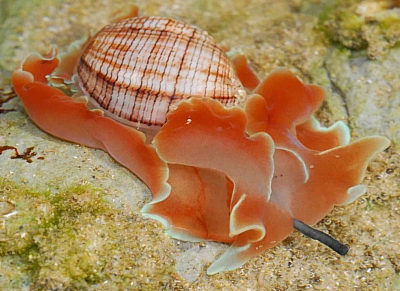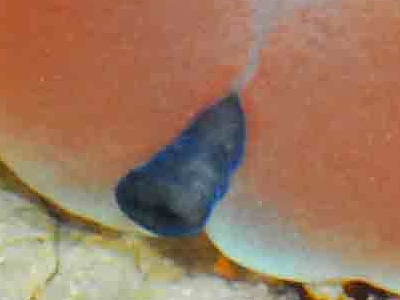Amazing proboscis on Hydatina physis from Sth Africa
April 8, 2008
From: Valda Fraser


Dear Bill
I've often seen Hydatina physis, but never this proboscis. Amazing! What is it for?
Locality: Mpande, 15 cm, Eastern Cape, South Africa, Indian, 15 March 2008, intertidal pool. Length: 40 mm. Photographer: Valda Fraser.
Regards
Valda
valdafraser@mweb.co.za
Fraser, V.J., 2008 (Apr 8) Amazing proboscis on Hydatina physis from Sth Africa. [Message in] Sea Slug Forum. Australian Museum, Sydney. Available from http://www.seaslugforum.net/find/21498
Dear Valda,
Thanks for these interesting photos. I have never seen Hydatina with its proboscis [= oral tube] extendedlike this but when I studied these animals 30 years ago I did find on dissection that they had a very long muscular oral tube. Some specimens also had remains of cirratulinid worms in their gut. Cirratulinid worms live in crevices or in sand burrows and feed by extending long sticky tentacles out over the nearby sand and rock to pick up detrital food particles. I suggested that during feeding, the long oral tube was extended out of the mouth so that the jaws and teeth on the end of it could be inserted into crevices and burrows to grasp these worms. There are large muscles attached to the oral tube which would then drag it back into the body. Your photos show that the oral tube does indeed extend some distance outside the mouth. I suspect it can extend at least twice as long again as in your upper photo.
Species of Micromelo, and some species of Bullina [B. lineata does, B. roseana doesn't] have a long oral tube like this. In 1972, I had no information on the feeding choice of Micromelo and Bullina but since then I have discovered cirratulinid worms, or parts of them, in the alimetary canal of both Micromelo undata and Bullina lineata.
- Rudman, W.B., 1972. The anatomy of the opisthobranch genus Hydatina and the functioning of the mantle cavity and alimentary canal. Zoological Journal of the Linnean Society, 51: 121-139.
- Rudman, W.B., 1972. Studies on the primitive opisthobranch genera Bullina Ferussac and Micromelo Pilsbry. Zoological Journal of the Linnean Society, 51: 105-119.
Best wishes,
Bill Rudman
Related messages
-
Re: Food for the bubble shell Hydatina physis?
From: Lindsay Lyles, December 16, 2009 -
Hydatina physis from sthn Queensland
From: Gary Cobb, January 21, 2009 -
Hydatina physis from Florida
From: Linda Ianniello, July 7, 2008 -
Hydatina physis from Gold Coast, Queensland
From: Ian Banks, May 20, 2006 -
Hydatina physis mating
From: Marina Poddubetskaia, July 2, 2005 -
Hydatina physis laying eggs
From: Marina Poddubetskaia, July 2, 2005 -
Mysterious pink nudibranch from New South Wales
From: Eliza Middleton, January 27, 2005 -
Hydatina physis laying eggs
From: Ian Hutton, January 28, 2004 -
Hydatina physis from Japan
From: Yukari Sato, December 20, 2003 -
Re: A rose of a different color
From: Paul Whitehead, October 6, 2003 -
Hydatina physis from Japan
From: Kayoko Eto, June 11, 2003 -
Pair of Hydatina physis
From: Leanne & David Atkinson, June 7, 2003 -
Hydatina physis from Senegal
From: Marina & Patrice , April 19, 2003 -
Hydatina physis from Lord Howe Island
From: W.B. Rudman, January 24, 2003 -
Hydatina physis - more photos
From: George Evatt, June 2, 2001 -
Hydatina physis in Sydney
From: George Evatt, June 1, 2001 -
A rose of a different color
From: Mary Jane Adams, June 6, 2000 -
Hydatina, again
From: Peter Wirtz, February 15, 2000 -
Hydatina stromfelti v Hydatina physis
From: Marco Neiber, February 2, 2000 -
Food for the bubble shell Hydatina physis?
From: Ian Smith, December 19, 1999 -
What is the 'Rose Petal Bubble Shell'?
From: Lauren Peck, August 23, 1999
